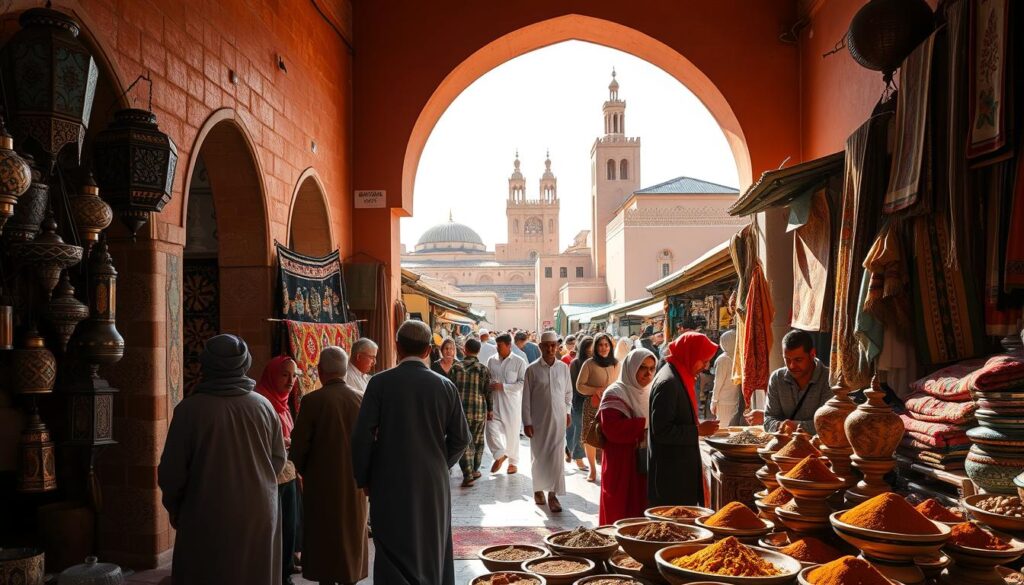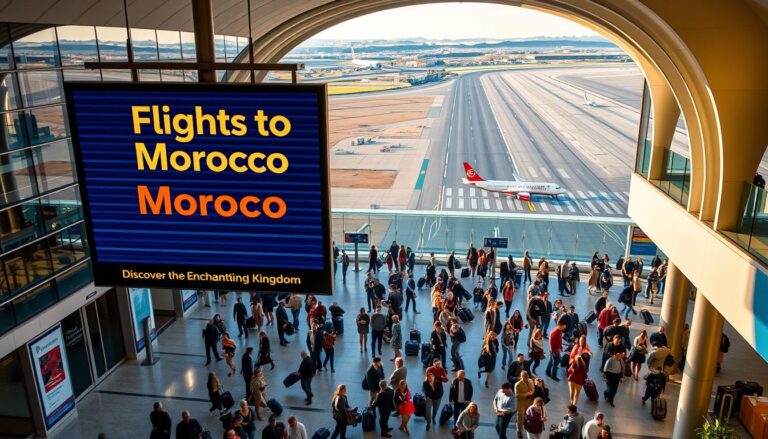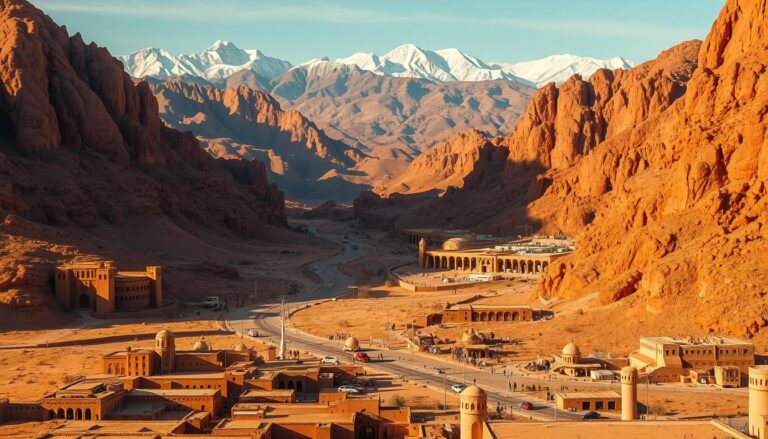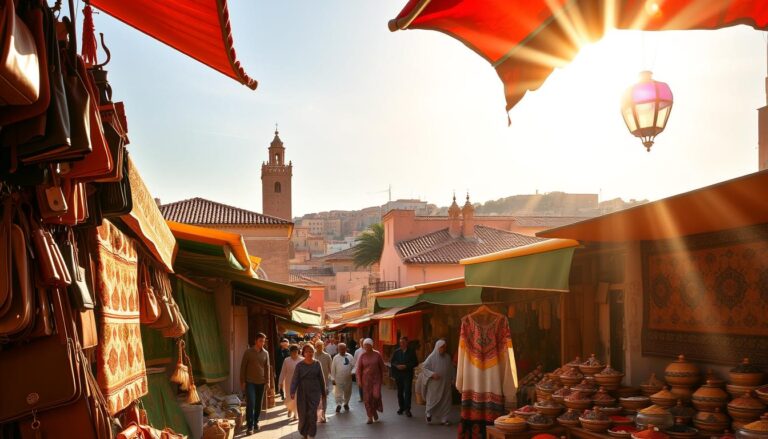Top 15 Things to Do in Morocco: A First-Timer’s Travel Guide
Table of Contents
Did you know Morocco welcomes over 13 million travellers annually – more than Egypt or South Africa? This North African gem’s allure lies in its dizzying contrasts: ancient medinas hum alongside surf-ready beaches, while snow-capped peaks melt into ochre deserts. Whether you’re bargaining for spices in Marrakesh’s souks or tracing Berber trails through the Atlas Mountains, every moment here feels like stepping into a living storybook.
Your journey might begin in Fez’s medieval labyrinth, where donkeys still haul goods through 9th-century alleyways. Later, you could be sipping mint tea in a riad courtyard or sandboarding down Erg Chebbi’s golden dunes. The country’s cultural tapestry reveals itself through experiences like traditional hammam rituals, Amazigh village stays, and sunset camel treks where the Sahara glows like molten copper.
What makes Morocco truly special is its accessibility. Modern trains connect imperial cities, while well-marked trails lead through remote valleys. You’ll find UNESCO World Heritage sites neighbour contemporary art galleries, and family-run guesthouses sit minutes from luxury resorts. This blend of authenticity and comfort explains why 83% of UK visitors return within five years – there’s always more to discover.
Key Takeaways
- Morocco’s diverse landscapes span from the Atlas Mountains to Atlantic coastlines, offering adventures for every traveller
- Cultural immersion opportunities abound through souk explorations, traditional hammams, and local cuisine experiences
- Spring and autumn provide ideal weather for exploring most regions, with coastal areas accessible year-round
- The country combines ancient heritage sites with modern amenities for comfortable yet authentic travel
- Photogenic highlights range from Chefchaouen’s blue streets to Saharan desert vistas at golden hour
- Efficient transport links between major destinations make itinerary planning straightforward for first-time visitors
Introduction: Embracing Morocco’s Magic
Where else can you surf Atlantic waves at dawn and sip mint tea in a desert camp beneath star-dusted skies by nightfall? This North African kingdom has lured everyone from 14th-century spice traders to Mick Jagger, weaving its spell through contrasts that feel plucked from a dream. Your journey here becomes a sensory feast – the scent of saffron in Fez’s tanneries, the kaleidoscope of handwoven carpets in Marrakesh, and the echo of muezzins calling across Chefchaouen’s blue-washed alleyways.
An Overview of Morocco’s Diverse Landscapes
Pack your boots and sunglasses – you’ll need both. The High Atlas’s snow-crowned peaks give way to four distinct ecosystems within a day’s drive. Mediterranean cliffs plunge into fishing villages where octopus dries on lines. Further south, palm-fringed oases dissolve into the Sahara’s endless dunes. Spring brings almond blossoms to mountain valleys, while autumn paints the Ourika Valley in fiery hues.
Why Your First Visit Will Be Unforgettable
Morocco’s true magic lies in its people. Share sweet msemen pancakes with Berber shepherds, or barter for silver in Agadir’s souk with a shopkeeper’s chuckle. Modern comforts blend seamlessly with tradition – zip from Casablanca to Tangier on Africa’s fastest train, then sleep in a 17th-century riad. Whether you’ve got three days or three weeks, every moment feels like unwrapping a gift. As a local proverb says: “The desert rewards those who walk slowly.”
Exploring the Vibrant Medinas of Marrakesh, Fez and Chefchaouen
These ancient walled cities form Morocco’s cultural heartbeat, where every turn reveals centuries-old craftsmanship and contemporary energy colliding. From the scarlet-hued ramparts of Marrakesh to Chefchaouen’s cerulean maze, each medina tells its own story through architecture, aromas, and artisan traditions.

Discovering Historic Markets and Labyrinthine Souks
In Marrakesh’s Red City, Djemaa El Fna transforms at dusk into an open-air theatre. Storytellers weave tales under lantern light while sizzling lamb tagine perfumes the air. Don’t miss the souk alleys branching from the square – follow the clang of copper-beaters to find hand-engraved lanterns.
Fez El Bali’s 9th-century medina feels like stepping into a living museum. Leather tanners pound hides in stone vats as they’ve done since medieval times. Look for the wooden workshop signs – your best navigation aids in this 9,000-alley labyrinth.
Chefchaouen’s blue-washed streets nestle in the Rif Mountains like crushed sapphires. Morning light turns walls into watercolour hues, perfect for photography. Combine your visit with a hike to Akchour’s waterfalls in Talassemtane National Park – cool off in turquoise pools beneath cascades.
Essential Tips for Navigating Bustling Streets
Local guides prove invaluable in Fez’s maze-like alleys – they’ll help you spot hidden landmark mosques and avoid dead ends. Spring and autumn offer ideal temperatures (15-25°C) for exploring without summer’s scorching heat.
Allow extra time for spontaneous discoveries – perhaps a communal bakery where locals bake bread or a rooftop café overlooking the medina. In Chefchaouen, climb to the Spanish Mosque at dusk for panoramic views over the blue city glowing in golden hour light.
Unmissable Things to Do in Morocco
Morocco’s cultural tapestry invites you to step beyond sightseeing into living traditions. From hands-on craft workshops to vineyard explorations, these encounters transform visitors into active participants in local heritage.
Immersive Cultural Activities
Begin in Morocco’s capital Rabat, where historic sights like the Hassan Tower meet contemporary art at the Mohammed VI Museum. Local guides bring these spaces to life with stories of dynasties and modern creativity.

Join a hands-on pottery class in Fes’ medina, shaping clay alongside fourth-generation artisans. In Casablanca, guided tours reveal the Hassan II Mosque’s staggering scale – its retractable roof opens to the stars during night prayers.
Unique Local Adventures to Cherish
Learn bread-making secrets in Atlas Mountain villages, kneading dough with Berber women. Share stories over mint tea during home-cooked meals, discovering regional dishes like rfissa (spiced chicken with lentils).
| Experience | Location | Highlight |
|---|---|---|
| Wine Tasting | Middle Atlas | Syrah-Grenache blends |
| Henna Artistry | Marrakesh | Natural plant dyes |
| Carpet Weaving | High Atlas | Symbolic Berber patterns |
| Calligraphy | Fes Medina | Arabic script mastery |
Multi-days itineraries let you dive deeper – perhaps combining Essaouira’s music festivals with responsible shopping in cooperative craft workshops. As the light fades, join spontaneous gnawa drum circles where locals welcome travellers into the rhythm.
Adventures in the Majestic Atlas Mountains
The Atlas Mountains form Morocco’s rugged backbone, where adrenaline and cultural discovery collide. This vast playground offers everything from gentle valley strolls to thigh-burning ascents, with Amazigh hospitality warming every mountain pass.
Trekking North Africa’s Highest Peaks
Strap on your boots for Jebel Toubkal – North Africa’s rooftop at 4,167 metres. The two-day climb from Imlil village rewards you with views stretching to the Sahara. Local guides share tales of jnoun (mountain spirits) while navigating scree slopes.
Prefer multi-day adventures? The week-long Toubkal Circuit winds through High Atlas villages where donkeys outnumber cars. You’ll sleep in family-run gîtes, waking to walnut bread baked in clay ovens. Keep eyes peeled for hidden waterfalls cascading into turquoise pools.
Exploring Traditional Amazigh Villages
The Anti Atlas near Tafraoute reveals Morocco’s quieter side. Here, 2,359-metre Jebel El Kest serves panoramic vistas without the crowds. Wander through terraced valleys where farmers tend apple orchards using methods unchanged for generations.
An Amazigh elder once told me: “Mountains teach patience – let your footsteps match your heartbeat.” Join village women grinding argan nuts or share mint tea with mule handlers. These moments reveal the true soul of Morocco’s mountain communities.
Coastal Escapades: Surfing, Windsurfing and More
Morocco’s Atlantic coastline serves up 3,500km of wave-kissed adventures, where salt-crusted fishing villages meet world-class surf breaks. Between Essaouira’s UNESCO-listed ramparts and Dakhla’s desert-fringed lagoons, you’ll find water sports to match every skill level.
Embracing the Atlantic Breezes
Essaouira earns its “Wind City of Africa” title with breezes that power windsurfers across Bay of Mogador. Thirty minutes south, Sidi Kaouki’s laid-back vibe and consistent waves make it perfect for first-time surfers. Budget-friendly guesthouses line the beachfront here – ideal for extended stays.
Head 130km south of Agadir to discover Mirleft’s hidden coves. Local surf school Spot-M offers tailored lessons beneath red-cliff backdrops. For adrenaline junkies, Dakhla’s kitesurfing scene delivers year-round winds across protected lagoons.
| Location | Activity | Best For |
|---|---|---|
| Essaouira | Windsurfing | Cultural combo trips |
| Sidi Kaouki | Surfing | Beginners |
| Mirleft | Surf tuition | Family groups |
| Dakhla | Kitesurfing | Advanced riders |
Time your coastal trip to catch sunset from Essaouira’s Skala du Port. Watch fishing boats bob beneath peach-hued skies before feasting on just-grilled sardines at harbour stalls. Many surf hostels organise beach bonfires – perfect for swapping stories with fellow travellers.
Beyond the waves, explore tidal islands with local fishermen or ride Arabian horses along deserted beaches. Luxury seekers will love boutique riads with ocean views, while budget travellers find surf camps offering board rentals and shared meals.
Indulge in Rejuvenating Hammam Experiences
Step into the steamy embrace of a Moroccan hammam, where centuries-old wellness rituals melt away travel fatigue. These communal bathhouses serve as social hubs and spiritual cleansers, offering more than mere relaxation – they’re gateways to cultural immersion.
Discover the Rituals of Local Bathhouses
Your experience begins with savon beldi, a velvety black soap made from olives. Attendants use kessa mitts to exfoliate dead skin in rhythmic motions – prepare to emerge glowing. Public neighbourhood spots buzz with local chatter, while luxury hotel versions add rose petal scrubs and argan oil massages.
First-timers often find the heat intense. Start with 10-minute steam sessions, gradually building tolerance. Essential gear includes plastic sandals and a wrap – most places rent these. Traditional hammams use ghassoul clay for detoxifying masks, leaving skin baby-soft.
For authentic interactions, visit mid-morning when locals unwind. Many bathhouses offer gender-segregated sessions or private bookings. Whether you choose a £5 scrub or £80 spa package, you’ll gain insight into Morocco’s cherished wellness tradition – the perfect finale to your adventures.







